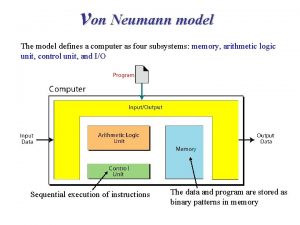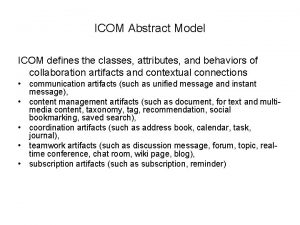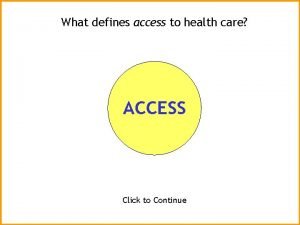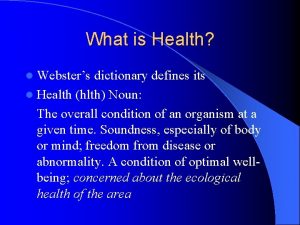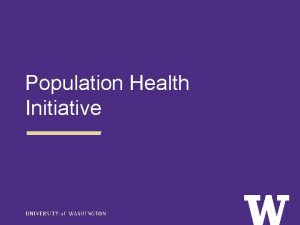Model of Health The model defines health in



















- Slides: 19

Model of Health The model defines health in the same way as the World Health Organization: “a state of complete physical, mental, and social well-being and not merely the absence of disease or infirmity. ” Like the World Health Organization, our goal is to achieve better health for all.

The enjoyment of the highest attainable standard of health is one of the fundamental right of every human being, without distinction of race, religion, political beliefs or economic and social conditions. WHO state that the social or wider determinants of health are “the conditions in which people are born, grow, live, work and age. These conditions or circumstances are shaped by the distribution of money, power and resources at global, national and local levels”. WHO makes clear the link between the social determinants of health and health inequalities, defined as “the unfair and avoidable difference in health status seen within and between countries. ” (WHO, 2012)

The medical model is a model of health which suggests that disease is detected and identified through a systematic process of observation, description, and differentiation, in accordance with standard accepted procedures, such as medical examinations, tests, or a set of symptom descriptions. It is set of procedures in which all doctors are trained". It includes complaint, history, physical examination, ancillary tests if needed, diagnosis, treatment, and prognosis with and without treatment. Focused in physical or biological aspect of disease. Emphasis on diagnosis and treating individuals separately from their lifestyle/living conditions. The reason for the illness are not at the center of medical model.

: Developed during the age of Enlightenment in the 18 th Century, when the traditional natural sciences began to dominate academia and medical practice. The belief that science could cure all illness and disease has remained a core element of modern medicine. This concept of health may be easier to understand as it makes health an attribute you can measure simply by determining if a disease is present or not. However the strong emphasis on the absence of disease as an indicator of good health, and the overdependence on the influence of medical science in health, ignores the power of other important influences.

Two aspect of Medical model Diagnosis: Identification of disease through Dr observation or diagnostic test like X-ray. Intervention Action taken to improve health via medical treatment, hospitalization and surgery etc. Example. Xray , surgery, blood test and ultrasound

Does this medical model of health address the definition of WHO? Disadvantages. Relies on professional health worker and technology and therefore is costly. Does not promote good health/narrow view of health like doesn’t encourage people to live healthy lives Not every condition can be treated like cancer Affordability- Not always affordable

BIOPSYCHOSOCIAL MODEL BIOPSYCHOSOCIAL MODEL: Developed by psychiatrist George Engel in 1977, and recognises that many factors affect health. It pays “explicit attention to humanness” (Engel, 1997). It views health as a scientific construct and a social phenomena. The model looks at the biological factors which affect health, such as age, illness, gender etc. The psychological factors: individual beliefs & perceptions. The social: the community, the presence or absence of relationships “We suffer when our interpersonal bonds are sundered and we feel solace when they are reestablished” (Engel, 1997)

ECOSYSTEM HEALTH ECOSYSTEM HEALTH: Humanity is part of and one among many in an environment that is being changed as result of human activity: land use, climate change, population growth, resource depletion, pollution, urbanization, loss of biodiversity, and other local and global processes all disrupt the natural self regulation of the biosphere. These changes harm people, domestic animals, wildlife, the oceans, and the forests. The crucial response has to be to redesign our relations with the rest of nature. (Levins and Lopez 1999)

An ecologic model of human health is consistent with the broad field of human ecology. which is “the study of the interactions of man and human society with the environment. It is concerned with the philosophy and quality of life in relation to the development of biological and geological resources, of urban and rural settlements, of industry and technology and of education and culture. Ecology identifies environmental factors and influences, which interact and affect individual behavior. These factors may be the physical setting or place, the human aggregate or characteristics of the people, organizational and social climate, and/or characteristics of the surrounding community.

SOCIAL MODEL OF HEALTH SOCIAL MODEL OF HEALTH: This model emerged from the social model of disability, which has been strongly advocated by the disability rights movement. It was developed as a reaction to the traditional medical model. The social model of health examines all the factors which contribute to health such as social, cultural, political and the environment. An example is poor housing: It is well documented that both stress and low self esteem can have a negative impact on health. “Low levels of autonomy and low self esteem are likely to relate to worse health. ” (Marmot, 2003) CDHN believes that communities know that their health is being affected by a variety of issues. We also believe that communities can and should be actively involved in identifying, planning, designing and implementing solutions to health issues and unjust health inequalities.

This model attempts to address the broader influence on health (Social, cultural, environmental and economic factors) rather than disease and injury. It is community approach to prevent disease and illness. Focus is on policies, educational and health promotion. This model was developed in late 1970.

5 key principles of social model of health Address the broader determinant of health such as gender, ethnicity, socioeconomic and environmental influence Reduce social inequalities. Empower individual and communities with skills and knowledge Access to health care ( accessible and appropriate health information). Inter sectorial collaboration (by involving organization and Government).

Advantage Education for people so don’t get disease. Govt support /strategies e. g immunization Less costly because prevent disease before happening. Community approach because all stakeholder involved. Improved quality of life and living style

Disadvantages Lack of education for whole population. Population not motivated e. g smoking Not believing it will happen to them Changing lifestyle is very hard Not all diseases can be prevented

The New Public Health (NPH) is an integrative approach to protecting and promoting the health status of both the individual and the society. The public health model is a concept with currency in many disciplines, including health, education and welfare. It is an epidemiological model that attempts to prevent or reduce a particular illness or social problem in a population by identifying risk indicators

Primary health care is a whole-of-society approach to health and well-being centred on the needs and preferences of individuals, families and communities. It addresses the broader determinants of health and focuses on the comprehensive and interrelated aspects of physical, mental and social health and wellbeing. Primary health care (PHC) addresses the majority of a person’s health needs throughout their lifetime. This includes physical, mental and social well-being and it is people-centred rather than disease-centred. PHC is a whole-ofsociety approach that includes health promotion, disease prevention, treatment, rehabilitation and palliative care

Three component of Primary Health Care A primary health care approach includes three components: meeting people’s health needs throughout their lives; addressing the broader determinants of health through multisectoral policy and action; and empowering individuals, families and communities to take charge of their own health. PHC, because it is about how best to provide health care and services to everyone, everywhere, is the most efficient and effective way to achieve health for all.

Primary health care promotes health and wellness and seeks to prevent injuries and illness. It’s about more than delivering health care services. It’s about creating the conditions that help people to become and stay healthy and well. It’s also about extending the reach of health care providers into communities. Accessibility — or making sure that primary care services are available, affordable and provided equally to all individuals irrespective of their gender, age, ethnicity or location. Public or community participation — or involving all of community’s resources in promoting health and addressing health problems at the grass roots level.

Health promotion— or helping a community to strengthen the socioeconomic conditions that contribute to good health. Appropriate use of technology — or using medical technologies that are affordable, feasible and culturally acceptable to individuals and the community.
 Iot design methodology has _________steps.
Iot design methodology has _________steps. Hình ảnh bộ gõ cơ thể búng tay
Hình ảnh bộ gõ cơ thể búng tay Bổ thể
Bổ thể Tỉ lệ cơ thể trẻ em
Tỉ lệ cơ thể trẻ em Voi kéo gỗ như thế nào
Voi kéo gỗ như thế nào Chụp phim tư thế worms-breton
Chụp phim tư thế worms-breton Chúa yêu trần thế alleluia
Chúa yêu trần thế alleluia Môn thể thao bắt đầu bằng từ đua
Môn thể thao bắt đầu bằng từ đua Thế nào là hệ số cao nhất
Thế nào là hệ số cao nhất Các châu lục và đại dương trên thế giới
Các châu lục và đại dương trên thế giới Công của trọng lực
Công của trọng lực Trời xanh đây là của chúng ta thể thơ
Trời xanh đây là của chúng ta thể thơ Mật thư anh em như thể tay chân
Mật thư anh em như thể tay chân Phép trừ bù
Phép trừ bù độ dài liên kết
độ dài liên kết Các châu lục và đại dương trên thế giới
Các châu lục và đại dương trên thế giới Thể thơ truyền thống
Thể thơ truyền thống Quá trình desamine hóa có thể tạo ra
Quá trình desamine hóa có thể tạo ra Một số thể thơ truyền thống
Một số thể thơ truyền thống




















